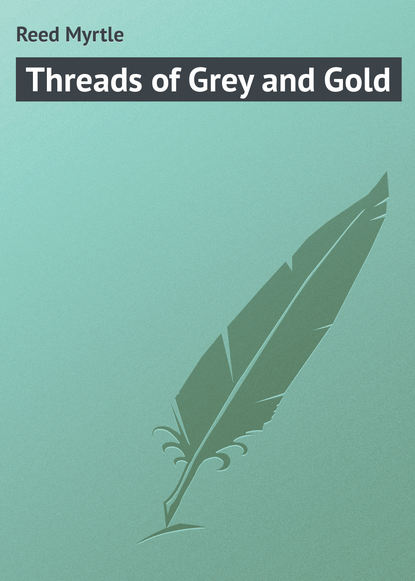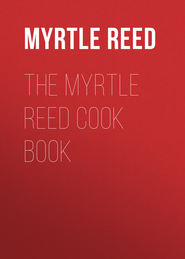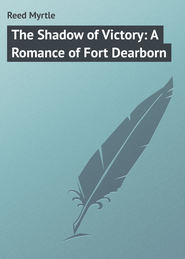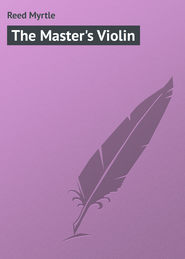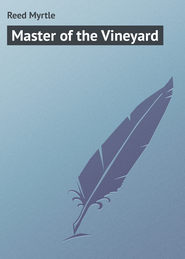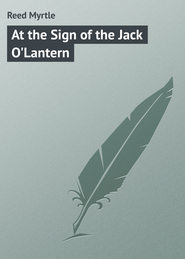По всем вопросам обращайтесь на: info@litportal.ru
(©) 2003-2024.
✖
Threads of Grey and Gold
Настройки чтения
Размер шрифта
Высота строк
Поля
With all due respect to Mr. Smith, one must insist that Margaret’s shoes were all right as regards material and build. She would have been more comfortable if they had been “high-necked” shoes, and, in that case, the yarn hosiery would not have troubled him, but that is a minor detail. The quibble comes at the belt, and knowing that Margaret was an artist, we must be sure that Mr. Smith was mistaken. It may have been one of the woven cotton belts, not more than two inches wide, which, for a dizzy moment, were at the height of fashion, and then tottered and fell, but a “saddle-girth” – never!
In that charming morceau, The Inn of the Silver Moon, Mr. Viele puts his heroine into plaid stockings and green knickerbockers – an outrageous costume truly, even for wheeling.
As if recognising his error, and, with veritable masculine stubbornness, refusing to admit it, Mr. Viele goes on to say that the knickerbockers were “tailor-made!” And thereby he makes a bad matter very much worse.
In The Wings of the Morning, Iris, in spite of the storm through which the Sirdar vainly attempts to make its way, appears throughout in a “lawn dress” – white, undoubtedly, since all sorts and conditions of men profess to admire white lawn!
How cold the poor girl must have been! And even if she could have been so inappropriately gowned on shipboard, she had plenty of time to put on a warm and suitable tailor-made gown before she was shipwrecked. This is sheer fatuity, for any one with Mr. Tracy’s abundant ingenuity could easily have contrived ruin for the tailored gown in time for Iris to assume masculine garb and participate bravely in that fearful fight on the ledge.
Whence, oh whence, comes this fondness for lawn? Are not organdies, dimities, and embroidered muslins fully as becoming to the women who trip daintily through the pages of men’s books? Lawn has been a back number for many a weary moon, and still we read of it!
“When in doubt, lead trumps,” might well be paraphrased thus: “When in doubt, put her into white lawn!” Even “J. P. M.,” that gentle spirit to whom so many hidden things were revealed, sent his shrewish “Kate” off for a canter through the woods in a white gown, and, if memory serves, it was lawn!
In The Master, Mr. Zangwill describes Eleanor Wyndwood as “the radiant apparition of a beautiful woman in a shimmering amber gown, from which her shoulders rose dazzling.”
So far so good. But a page or two farther on, that delightful minx, Olive Regan, wears “a dress of soft green-blue cut high, with yellow roses at the throat.” One wonders whether Mr. Zangwill ever really saw a woman in any kind of a gown “with yellow roses at the throat,” or whether it is but the slip of an overstrained fancy. The fact that he has married since writing this gives a goodly assurance that by this time he knows considerably more about gowns.
Still there is always a chance that the charm may not work, for Mr. Arthur Stringer, who has been reported as being married to a very lovely woman, takes astonishing liberties in The Silver Poppy:
“She floated in before Reppellier, buoyant, smiling, like a breath of open morning itself, a confusion of mellow autumnal colours in her wine-coloured gown, and a hat of roses and mottled leaves.
“Before she had as much as drawn off her gloves – and they were always the most spotless of white gloves – she glanced about in mock dismay, and saw that the last of the righting up had already been done.”
Later, we read that the artist pinned an American Beauty upon her gown, then shook his head over the colour combination and took it off. If the American Beauty jarred enough for a man to notice it, the dress must have been the colour of claret, or Burgundy, rather than the clear soft gold of sauterne.
This brings us up with a short turn before the hat. What colour were the roses? Surely they were not American Beauties, and they could not have been pink. Yellow roses would have been a fright, so they must have been white ones, and a hat covered with white roses is altogether too festive to wear in the morning. The white gloves also would have been sadly out of place.
What a comfort it would be to all concerned if the feminine reader could take poor Cordelia one side and fix her up a bit! One could pat the artistic disorder out of her beautiful yellow hair, help her out of her hideous clothes into a grey tailor-made, with a shirt-waist of mercerised white cheviot, put on a stock of the same material, give her a “ready-to-wear” hat of the same trig-tailored quality, and, as she passed out, hand her a pair of grey suède gloves which exactly matched her gown.
Though grey would be more becoming, she might wear tan as a concession to Mr. Stringer, who evidently likes yellow.
In the same book, we find a woman who gathers up her “yellow skirts” and goes down a ladder. It might have been only a yellow taffeta drop-skirt under tan etamine, but we must take his word for it, as we did not see it and he did.
As the Chinese keep the rat tails for the end of the feast, the worst clothes to be found in any book must come last by way of climax. Mr. Dixon, in The Leopard’s Spots, has easily outdone every other knight of the pen who has entered the lists to portray women’s clothes. Listen to the inspired description of Miss Sallie’s gown!
“She was dressed in a morning gown of a soft red material, trimmed with old cream lace. The material of a woman’s dress had never interested him before. He knew calico from silk, but beyond that he never ventured an opinion. To colour alone he was responsive. This combination of red and creamy white, with the bodice cut low, showing the lines of her beautiful white shoulders, and the great mass of dark hair rising in graceful curves from her full round neck, heightened her beauty to an extraordinary degree.
“As she walked, the clinging folds of her dress, outlining her queenly figure, seemed part of her very being, and to be imbued with her soul. He was dazzled with the new revelation of her power over him.”
The fact that she goes for a ride later on, “dressed in pure white,” sinks into insignificance beside this new and original creation of Mr. Dixon’s. A red morning gown, trimmed with cream lace, cut low enough to show the “beautiful white shoulders” – ye gods and little fishes! Where were the authorities, and why was not “Miss Sallie” taken to the detention hospital, pending an inquiry into her sanity?
It would seem that any man, especially one who writes books, could be sure of a number of women friends. Among these there ought to be at least one whom he could take into his confidence. The gentleman novelist might go to the chosen one and say: “My heroine, in moderate circumstances, is going to the matinée with a girl friend. What shall she wear?”
Instantly the discerning woman would ask the colour of her eyes and hair, and the name of the town she lived in, then behold!
Upon the writer’s page would come a radiant feminine vision, clothed in her right mind and in proper clothes, to the joy of every woman who reads the book.
But men are proverbially chary of their confidence, except when they are in love, and being in love is supposed to put even book women out of a man’s head. Perhaps in the new Schools of Journalism which are to be inaugurated, there will be supplementary courses in millinery elective, for those who wish to learn the trade of novel writing.
If a man knows no woman to whom he can turn for counsel and advice at the critical point in his book, there are only two courses open to him, aside from the doubtful one of evasion. He may let his fancy run riot and put his heroine into clothes that would give even a dumb woman hysterics, or he may follow the example of Mr. Chatfield-Taylor, who says of one of his heroines that “her pliant body was enshrouded in white muslin with a blue ribbon at the waist.”
Lacking the faithful hench-woman who would gladly put them straight, the majority of gentlemen novelists evade the point, and, so far as clothes are concerned, their heroines are as badly off as the Queen of Spain was said to be for legs.
They delve freely into emotional situations, and fearlessly attempt profound psychological problems, but slide off like frightened crabs when they strike the clothesline.
After all, it may be just as well, since fashion is transient and colours and material do not vary much. Still, judging by the painful mistakes that many of them have made, the best advice that one can give the gallant company of literary craftsmen is this: “When you come to millinery, crawfish!”
Maidens of the Sea
Far out in the ocean, deep and blue,
Where the winds dance wild and free,
In coral caves, dwells a beautiful band —
The maidens of the sea.
There are stories old, of the mystic tide,
And legends strange, of the deep,
How the witching sound of the siren’s song
Can lull the tempest to sleep.
When moonlight falls on a crystal sea,
When the clouds have backward rolled,
The mermaids sing their low sweet songs,
And their harp strings are of gold.
The billows come from the vast unknown —
From their far-away unseen home;
The waves bring shells to the sandy bar,
And the fairies dance on the foam.
The Technique of the Short Story
An old rule for those who would be well-dressed says: “When you have finished, go to the mirror and see what you can take off.” The same rule applies with equal force to the short story: “When you have written it out, go over it carefully, and see what you can take out.”
Besides being the best preparation for the writing of novels, short-story writing is undoubtedly, at the present time, the best paying and most satisfactory form of any ephemeral literary work. The qualities which make it successful are to be attained only by constant and patient practice. The real work of writing a story may be brief, but years of preparation must be worked through before a manuscript, which may be written in an hour or so, can present an artistic result.
The first and most important thing to consider is the central idea. There are only a few ideas in the world, but their ramifications are countless, and one need never despair of a theme. Your story may be one of either failure or success, but it must have the true ring. Given the man and the circumstances, we should know his action.
The plot must unfold naturally; otherwise it will be a succession of distinct sensations, rather than a complete and harmonious whole.
There is no better way to produce this effect than to follow Edmund Russell’s rule of colour in dress: “When a contrasting colour is introduced, there should be at least two subordinate repetitions of it.”
Each character should appear, or be spoken of, at least twice before his main action. Following this rule makes one of the differences between artistic and sensational literature.
The heroine of a dime novel always finds a hero to rescue her in the nick of time, and perhaps she never sees him again. In the artistic novel, while the heroine may see the rescuer first at the time she needs him most, he never disappears altogether from the story.
Description is a thing which is much abused. There is no truer indication of an inexperienced hand than a story beginning with a description of a landscape which is not necessary to the plot. If the peculiarities of the scenery must be understood before the idea can be developed, the briefest possible description is not out of place. Subjectively, a touch of landscape or weather is allowable, but it must be purely incidental. Weather is a very common thing and is apt to be uninteresting.
It is a mistake to tell anything yourself which the people in the story could inform the reader without your assistance. A conversation between two people will bring out all the facts necessary as well as two pages of narration by the author.
In that charming morceau, The Inn of the Silver Moon, Mr. Viele puts his heroine into plaid stockings and green knickerbockers – an outrageous costume truly, even for wheeling.
As if recognising his error, and, with veritable masculine stubbornness, refusing to admit it, Mr. Viele goes on to say that the knickerbockers were “tailor-made!” And thereby he makes a bad matter very much worse.
In The Wings of the Morning, Iris, in spite of the storm through which the Sirdar vainly attempts to make its way, appears throughout in a “lawn dress” – white, undoubtedly, since all sorts and conditions of men profess to admire white lawn!
How cold the poor girl must have been! And even if she could have been so inappropriately gowned on shipboard, she had plenty of time to put on a warm and suitable tailor-made gown before she was shipwrecked. This is sheer fatuity, for any one with Mr. Tracy’s abundant ingenuity could easily have contrived ruin for the tailored gown in time for Iris to assume masculine garb and participate bravely in that fearful fight on the ledge.
Whence, oh whence, comes this fondness for lawn? Are not organdies, dimities, and embroidered muslins fully as becoming to the women who trip daintily through the pages of men’s books? Lawn has been a back number for many a weary moon, and still we read of it!
“When in doubt, lead trumps,” might well be paraphrased thus: “When in doubt, put her into white lawn!” Even “J. P. M.,” that gentle spirit to whom so many hidden things were revealed, sent his shrewish “Kate” off for a canter through the woods in a white gown, and, if memory serves, it was lawn!
In The Master, Mr. Zangwill describes Eleanor Wyndwood as “the radiant apparition of a beautiful woman in a shimmering amber gown, from which her shoulders rose dazzling.”
So far so good. But a page or two farther on, that delightful minx, Olive Regan, wears “a dress of soft green-blue cut high, with yellow roses at the throat.” One wonders whether Mr. Zangwill ever really saw a woman in any kind of a gown “with yellow roses at the throat,” or whether it is but the slip of an overstrained fancy. The fact that he has married since writing this gives a goodly assurance that by this time he knows considerably more about gowns.
Still there is always a chance that the charm may not work, for Mr. Arthur Stringer, who has been reported as being married to a very lovely woman, takes astonishing liberties in The Silver Poppy:
“She floated in before Reppellier, buoyant, smiling, like a breath of open morning itself, a confusion of mellow autumnal colours in her wine-coloured gown, and a hat of roses and mottled leaves.
“Before she had as much as drawn off her gloves – and they were always the most spotless of white gloves – she glanced about in mock dismay, and saw that the last of the righting up had already been done.”
Later, we read that the artist pinned an American Beauty upon her gown, then shook his head over the colour combination and took it off. If the American Beauty jarred enough for a man to notice it, the dress must have been the colour of claret, or Burgundy, rather than the clear soft gold of sauterne.
This brings us up with a short turn before the hat. What colour were the roses? Surely they were not American Beauties, and they could not have been pink. Yellow roses would have been a fright, so they must have been white ones, and a hat covered with white roses is altogether too festive to wear in the morning. The white gloves also would have been sadly out of place.
What a comfort it would be to all concerned if the feminine reader could take poor Cordelia one side and fix her up a bit! One could pat the artistic disorder out of her beautiful yellow hair, help her out of her hideous clothes into a grey tailor-made, with a shirt-waist of mercerised white cheviot, put on a stock of the same material, give her a “ready-to-wear” hat of the same trig-tailored quality, and, as she passed out, hand her a pair of grey suède gloves which exactly matched her gown.
Though grey would be more becoming, she might wear tan as a concession to Mr. Stringer, who evidently likes yellow.
In the same book, we find a woman who gathers up her “yellow skirts” and goes down a ladder. It might have been only a yellow taffeta drop-skirt under tan etamine, but we must take his word for it, as we did not see it and he did.
As the Chinese keep the rat tails for the end of the feast, the worst clothes to be found in any book must come last by way of climax. Mr. Dixon, in The Leopard’s Spots, has easily outdone every other knight of the pen who has entered the lists to portray women’s clothes. Listen to the inspired description of Miss Sallie’s gown!
“She was dressed in a morning gown of a soft red material, trimmed with old cream lace. The material of a woman’s dress had never interested him before. He knew calico from silk, but beyond that he never ventured an opinion. To colour alone he was responsive. This combination of red and creamy white, with the bodice cut low, showing the lines of her beautiful white shoulders, and the great mass of dark hair rising in graceful curves from her full round neck, heightened her beauty to an extraordinary degree.
“As she walked, the clinging folds of her dress, outlining her queenly figure, seemed part of her very being, and to be imbued with her soul. He was dazzled with the new revelation of her power over him.”
The fact that she goes for a ride later on, “dressed in pure white,” sinks into insignificance beside this new and original creation of Mr. Dixon’s. A red morning gown, trimmed with cream lace, cut low enough to show the “beautiful white shoulders” – ye gods and little fishes! Where were the authorities, and why was not “Miss Sallie” taken to the detention hospital, pending an inquiry into her sanity?
It would seem that any man, especially one who writes books, could be sure of a number of women friends. Among these there ought to be at least one whom he could take into his confidence. The gentleman novelist might go to the chosen one and say: “My heroine, in moderate circumstances, is going to the matinée with a girl friend. What shall she wear?”
Instantly the discerning woman would ask the colour of her eyes and hair, and the name of the town she lived in, then behold!
Upon the writer’s page would come a radiant feminine vision, clothed in her right mind and in proper clothes, to the joy of every woman who reads the book.
But men are proverbially chary of their confidence, except when they are in love, and being in love is supposed to put even book women out of a man’s head. Perhaps in the new Schools of Journalism which are to be inaugurated, there will be supplementary courses in millinery elective, for those who wish to learn the trade of novel writing.
If a man knows no woman to whom he can turn for counsel and advice at the critical point in his book, there are only two courses open to him, aside from the doubtful one of evasion. He may let his fancy run riot and put his heroine into clothes that would give even a dumb woman hysterics, or he may follow the example of Mr. Chatfield-Taylor, who says of one of his heroines that “her pliant body was enshrouded in white muslin with a blue ribbon at the waist.”
Lacking the faithful hench-woman who would gladly put them straight, the majority of gentlemen novelists evade the point, and, so far as clothes are concerned, their heroines are as badly off as the Queen of Spain was said to be for legs.
They delve freely into emotional situations, and fearlessly attempt profound psychological problems, but slide off like frightened crabs when they strike the clothesline.
After all, it may be just as well, since fashion is transient and colours and material do not vary much. Still, judging by the painful mistakes that many of them have made, the best advice that one can give the gallant company of literary craftsmen is this: “When you come to millinery, crawfish!”
Maidens of the Sea
Far out in the ocean, deep and blue,
Where the winds dance wild and free,
In coral caves, dwells a beautiful band —
The maidens of the sea.
There are stories old, of the mystic tide,
And legends strange, of the deep,
How the witching sound of the siren’s song
Can lull the tempest to sleep.
When moonlight falls on a crystal sea,
When the clouds have backward rolled,
The mermaids sing their low sweet songs,
And their harp strings are of gold.
The billows come from the vast unknown —
From their far-away unseen home;
The waves bring shells to the sandy bar,
And the fairies dance on the foam.
The Technique of the Short Story
An old rule for those who would be well-dressed says: “When you have finished, go to the mirror and see what you can take off.” The same rule applies with equal force to the short story: “When you have written it out, go over it carefully, and see what you can take out.”
Besides being the best preparation for the writing of novels, short-story writing is undoubtedly, at the present time, the best paying and most satisfactory form of any ephemeral literary work. The qualities which make it successful are to be attained only by constant and patient practice. The real work of writing a story may be brief, but years of preparation must be worked through before a manuscript, which may be written in an hour or so, can present an artistic result.
The first and most important thing to consider is the central idea. There are only a few ideas in the world, but their ramifications are countless, and one need never despair of a theme. Your story may be one of either failure or success, but it must have the true ring. Given the man and the circumstances, we should know his action.
The plot must unfold naturally; otherwise it will be a succession of distinct sensations, rather than a complete and harmonious whole.
There is no better way to produce this effect than to follow Edmund Russell’s rule of colour in dress: “When a contrasting colour is introduced, there should be at least two subordinate repetitions of it.”
Each character should appear, or be spoken of, at least twice before his main action. Following this rule makes one of the differences between artistic and sensational literature.
The heroine of a dime novel always finds a hero to rescue her in the nick of time, and perhaps she never sees him again. In the artistic novel, while the heroine may see the rescuer first at the time she needs him most, he never disappears altogether from the story.
Description is a thing which is much abused. There is no truer indication of an inexperienced hand than a story beginning with a description of a landscape which is not necessary to the plot. If the peculiarities of the scenery must be understood before the idea can be developed, the briefest possible description is not out of place. Subjectively, a touch of landscape or weather is allowable, but it must be purely incidental. Weather is a very common thing and is apt to be uninteresting.
It is a mistake to tell anything yourself which the people in the story could inform the reader without your assistance. A conversation between two people will bring out all the facts necessary as well as two pages of narration by the author.





